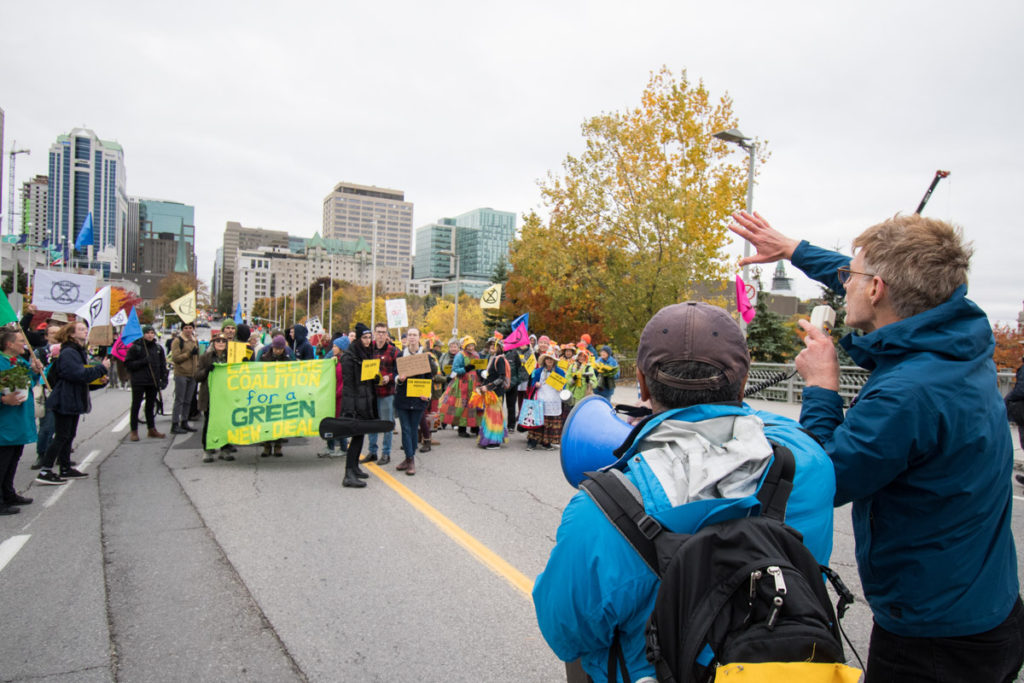Protesters with Extinction Rebellion blocked traffic on Laurier Avenue Bridge in downtown Ottawa on Oct. 18, demanding action on climate change.
Beginning in the U.K. last October, but an international movement now, Extinction Rebellion uses non-violent civil disobedience to raise awareness about the magnitude of climate change and demand changes from the government to address it.
Before blocking the bridge, organizers passed out flyers informing participants of their rights if arrested. A speaker explained that those who wanted to be arrested should remain in the street after police ask them to move.
“We’re really risking almost nothing here,” said Brendan Currie-O’Brien, a first-year student at Carleton University. “The point of getting arrested is to say, I’m willing to risk just a little bit of our freedom to say that this issue is important to us.”
Friday’s “BridgeOut” contributed to the organization’s International Week of Rebellion.
“We hope to basically just take hold of the bridge for as long as possible,” Currie-O’Brien, said before the protest. “It’s an effort to tell our government and our fellow citizens that not enough is being done for the impending climate catastrophe that we’re facing.”
Protestors stood at either end of the bridge with potted plants and signs, which included yellow and red “Act Now” lettering the movement uses in all its protests.

“I think Extinction Rebellion, in terms of the intent to disrupt business as usual, seems to me like a very good part of that range of options,” she said.
“Climate change is the most pressing and biggest challenge we face, and we all need to find ways to step up.”
The protest also served as the final destination for Ann Cognito, who walked across the country from Calgary with her dog, hoping to meet with the prime minister.
Cognito arrived in Ottawa on Tuesday, and plans to camp out on Parliament Hill till she meets with the prime minister.
There are three key issues Cognito hopes to address in the meeting: ensuring the government publicly addresses climate change, works to reduce carbon emissions in Canada to net zero by 2025, and creates regional, national and international assemblies to oversee the changes.
Cognito has been travelling on foot and bike with her dog to Ottawa as part of what she calls The Expedition: Walk to Waken the Nation, since April.
Xenia Vakova made a similar journey from Toronto.
“As individuals, we do difficult and impossible things all the time,” said Vakova. “So our government should be able to as well.”
Kevin Amirault, a masters student at Carleton, expressed concern over what impact climate change could have in his intended career in social work.
“I’m really concerned about the disproportionate impact of climate change on the most marginalized and disadvantaged,” Amirault said.
After years of inaction, activists—aided by social media—are increasing pressure on governments and businesses, said Peter Andrée, a professor at Carleton University and an expert in environmental politics.
“I applaud, frankly, groups that are thinking about nonviolent direct action,” said Andrée.
But Andrée also said he believes these actions could alienate some of the same people they attempt to persuade.
“They can easily end up sending the wrong messages,” he said.
Beginning Oct. 23, Extinction Rebellion Canada will be hosting XR52 for 52 weeks of arrestable direct action.
Feature image by Spencer Colby.






